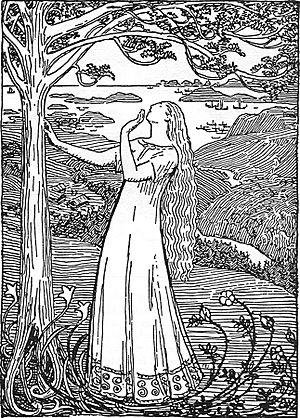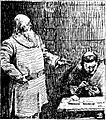Saga facts for kids
Sagas are exciting stories from a long time ago. Most of them are about life in ancient Scandinavia (Northern Europe) and among Germanic peoples. Some sagas are made-up tales, like fiction. Others are based on real historical events.
These stories often tell about early Vikings and their amazing journeys. They describe big battles that happened during these trips. Sagas also talk about people moving to Iceland and the arguments, or feuds, between families there. They were mainly written in Iceland in the Old Norse language.
Sagas are written in prose, which means they are like regular stories, not poems. But sometimes, they include parts that are poems. These poems often use a special sound pattern called alliterative verse. Sagas tell about brave actions and "worthy men" from the past. Many of these heroes were Vikings. Some believed in old pagan gods, while others were Christian.
Even though some sagas are fantastic or romantic, they always feature people we can understand. The best sagas are considered great literature. Njál's Saga, also known as the Saga of Burnt Njál, is one of the most famous.
Some sagas were also written in England. For example, Beowulf is an old English saga. Gawain and the Green Knight is another imaginative story from England. Layamon's Brut, written around 1200 AD, tells about English history.
Contents
What Are Sagas?
Sagas are long stories that were first told by word of mouth. Later, people wrote them down. They give us a peek into the lives of people who lived many centuries ago. These stories often mix real history with exciting legends.
Most sagas come from Iceland. They were written down between the 12th and 15th centuries. The people who wrote them wanted to remember their history. They also wanted to share thrilling tales of adventure.
Types of Sagas
There are different kinds of sagas. Each type focuses on different topics:
- Kings' Sagas: These tell the stories of the kings of Norway. They describe their lives, battles, and how they ruled.
- Sagas of Icelanders: These are about the families who first settled in Iceland. They often focus on conflicts and important events in their lives.
- Legendary Sagas: These stories are more like myths and legends. They often feature heroes, monsters, and magical events. They are not based on real history.
- Contemporary Sagas: These sagas describe events that happened closer to the time they were written. They give us details about medieval Icelandic society.
Why Are Sagas Important?
Sagas are very important for several reasons:
- History: They teach us about the history of Scandinavia and Iceland. They describe how people lived, what they believed, and how their societies worked.
- Literature: Many sagas are beautifully written. They are full of drama, strong characters, and exciting plots.
- Culture: Sagas help us understand the culture of the Norse people. They show their values, their laws, and their way of thinking.
- Language: They are written in Old Norse. This language is the ancestor of modern Icelandic, Norwegian, Danish, and Swedish.
Famous Sagas to Explore
Many sagas are still read and enjoyed today. Here are a few well-known examples:
- Njál's Saga: This is one of the longest and most famous sagas. It tells a dramatic story of friendship, betrayal, and revenge in Iceland.
- Egil's Saga: This saga is about a Viking warrior and poet named Egil Skallagrímsson. It shows his adventures, battles, and his strong personality.
- Grettir's Saga: This story follows the life of Grettir the Strong. He is an outlaw who faces many challenges and fights against evil spirits.
Sagas are amazing windows into a distant past. They offer thrilling adventures and valuable lessons about human nature.
Images for kids
-
Snorri Sturluson, portrait by Christian Krohg: Illustration for Heimskringla 1899-Edition
-
Excerpt from Njáls saga in the manuscript Möðruvallabók (AM 132 folio 13r) c. 1350.
See also
 In Spanish: Saga (literatura) para niños
In Spanish: Saga (literatura) para niños




